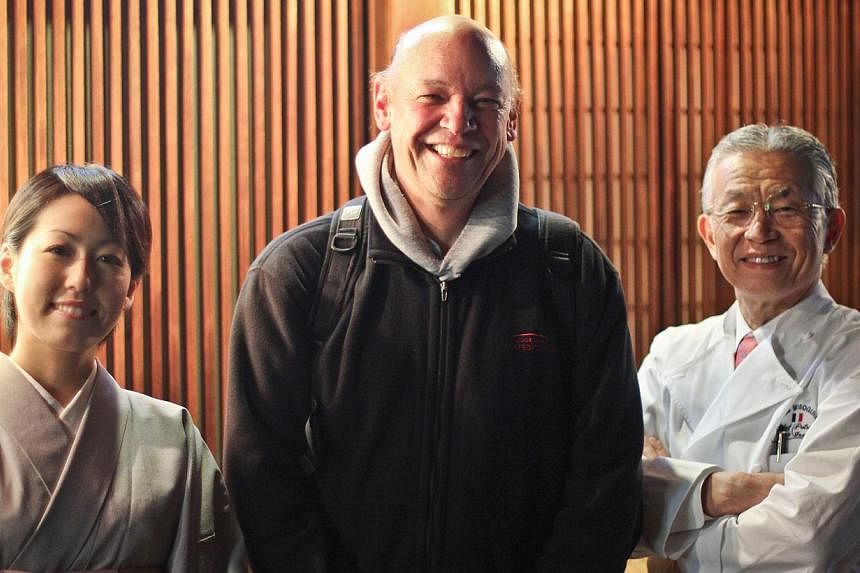Who: Don George, 61, is the editor-at-large for National Geographic Traveler and editor of BBC Travel's literary travel section, Words And Wanderlust. He edits a literary anthology each year for Lonely Planet.
Favourite city: Kyoto, Japan
Why: It enchants me most powerfully. It's the embodiment of old and abiding Japan for me, a place where a keen appreciation for artful, mindful everyday life still thrives and where peaceful, out-of-time pockets abound.
In the past quarter-century, I have visited Kyoto a dozen times. The city varies slightly each time - just as I vary slightly each time - but the character and creations that enchant me remain essentially the same.
Favourite places to stay
When it comes to accommodation, I have taken both the high road and the low road in Kyoto.
For the highest road, the place to stay is the venerable ryokan (Japanese-style inn) Tawaraya (Aneyakoji-agaru, fuya-cho, Nakagyo-ku, 604-8094, tel: +81-75-211-5566), where emperors and movie stars stay.
Staying here is like sleeping in a tatami-matted museum, surrounded by priceless antiques, and immerses you in the traditional hospitality of Japan (including an extraordinary kaiseki-style dinner).
A night's stay for two with breakfast and dinner costs about ¥112,000 (S$1,368).
If taking the low road is your preference (or your necessity), you can still stay stylishly for a very affordable price at the capsule hotel 9 Hours (588 Teianmaeno-cho, Shijyo, Teramachi-dori, Shimogyo-ku, 600-8031, tel: +81-75-353-7337). This is a true capsule hotel, not for the claustrophobic.
The rate for a night's stay would be ¥4,900 for one, without meals.
Favourite Kyoto tea shop
Tranquil Rakusho (Kodaiji Kitamon-mae-dori, 516 Washio-cho, Higashiyama-ku, 605-0072, tel: +81-75-561-6892), located on my favourite street in Kyoto, Nene-no-Michi.
Rakusho serves coffee, tea and a variety of sweets. Its speciality is warabi-mochi, a delicious gelatin-like treat made from rice paste and dusted with kinako, golden- coloured roasted soybean flour. I also love its iced coffee. A coffee or tea with mochi would cost about ¥700.
The exquisite garden on the two sides of the teahouse is famed for its prize-winning carp - but it's also a delightful and calming example of traditional Japanese landscape art.
Best place for dinner
That would be Misoguigawa (137 Wakamatsucho, Nakagyo Ward, 604-8011, tel: +81-75-221-2270), a wonderful restaurant that marries traditional French and Japanese cuisine in an absolutely heavenly way, serving dishes influenced by classic French cuisine in Japanese kaiseki style - that is, small portions of regional, seasonal fare served in exquisite ceramic and lacquered plates and bowls.
The restaurant is located on the highly atmospheric, lanterned lane called Pontocho-dori and is housed in a former geisha house on the banks of the Kamo River. The service is warm and attentive, and the cuisine is out of this world. For an unforgettable treat, choose the 11-course, ¥30,000 Seasonal Menu (tax and service not included).
Must try in Kyoto
There are some delightful restaurants that specialise in tofu. Probably the most amazing is Shoraian (Kanyuchinai, Sagakamenoocho, Ukyo-ku, 616-8386, tel: +81 75-861-0123), ensconced among towering trees by a river. When I'm wandering the streets in spring or summer, I always stop for a soft-serve green tea ice cream from a street-side stall. Delicious.
Best places to shop
I highly recommend you wander the area of Higashiyama-Kiyomizu-dera. The cobbled alleys here are filled with intriguing boutiques showcasing traditional Japanese crafts.
One great stop in this area is Asahido (1-280, Kiyomizu, Higashiyama-ku, 605-0862, tel: +81-75-531-2181), which features a wide variety of Kiyomizu pottery. The area around Asahido includes craft shops selling woodblock prints, lacquerware, bamboo crafts and dyed textiles, among other traditional creations.
For food lovers, Nishiki Market near the centre of downtown is a paradise of stalls selling fresh produce, fruit and traditional Japanese culinary concoctions.
Must-see places
My top few: Ryoanji Temple, especially the rock garden; Saiho-ji, also known as the Moss Temple (you have to reserve a visit in advance); Kiyomizu-dera; Kinkaku-ji; Ginkaku-ji; Nijo castle; Katsura Rikyu villa; Heian Jingu; Kodai-ji. These are just the tip of the tip of the sightseeing iceberg and are places of great historical importance. Many of these are also important in relation to Japan's religious and spiritual heritage.
Must-get souvenirs from Kyoto
I always bring home something small, such as elegantly decorated chopsticks or sleek wooden spoons, and something delicious like yatsuhashi sweets (a triangular dumpling-like confection made from rice powder, cinnamon and sugar, wrapped around red bean paste). When I want to splurge a bit, the elegant lacquerware and pottery always entice me.
Best place to people-watch in Kyoto
Gion, one of the traditional entertainment districts where geisha live. A visit at dusk or late at night may well provide glimpses of maiko (apprentice geisha) and geiko (professional geisha) entertainers.
Most memorable experience in Kyoto
One great treat recently was experiencing a tea ceremony at En (272 Matsubara-cho, Higashiyama-ku, intersection of Higashioji Street and Shinbashi Street, 605-0063, Tel: +81-80-3782-2706), a small teahouse in the Gion area with a tatami tearoom. The traditional ochanoyu - tea ceremony - was conducted by a very warm, personable, and knowledgeable tea ceremony master who explained the rites in excellent English.
A piece of advice for travellers going to Kyoto
Leave your guidebook in your hotel room and wander on your own.
After you've visited your chosen historic/cultural monument, take an hour and just wander around the area, stopping at shops and window-browsing, talking with the shopkeepers. Some speak English and, with those who don't, sign language works wonders.
Kyoto is full of treasures, and often your most memorable experiences will come from opening your eyes and heart and wandering off the tourist path.


